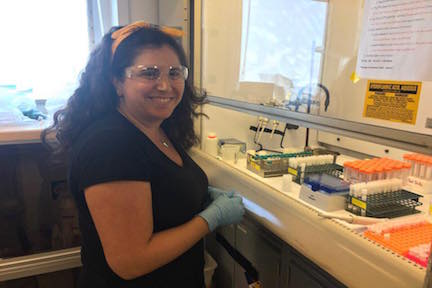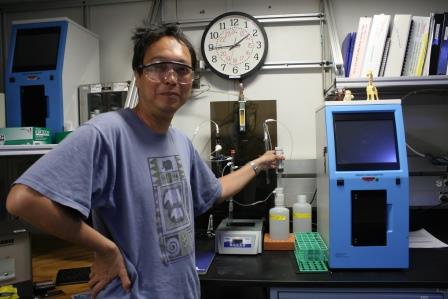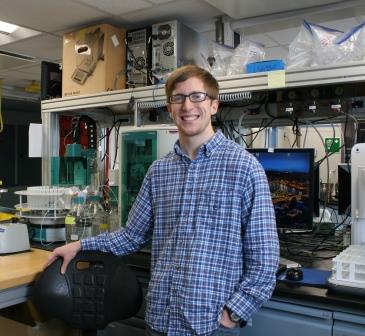
We would not be allowed to drill without the geochemists.
Tali, Dan and Masanobu make up the noon to midnight shift in thegeochemistry laboratory. This team of scientists undertake some important initial analysis of the sediment.

JOIDES Resolution is a ‘riserless’ drilling vessel, which means it is not equipped to drill into sediment containing quantities of gas or oil hydrocarbons. Masanobu with his strong background in petroleum chemistry has the role of quickly and carefully analyzing samples of sediment for traces of methane, ethane and propane. Methane (natural gas) can be made by the biological break down of once living organic matter. If a high amount of ethane and propane are also found this can indicate that organic matter has been broken down by heat (thermogenically). Alarm bells ring as this can indicate we might be accidentally drilling into an oil or gas deposit. This would be both dangerous and environmentally disastrous.
Masanobu has a first degree and masters from Tohoku University both in Petroleum Geochemistry. Gradually he found his interest changing towards prehistoric oceans and climates so he now works as a paleooceanographer at Hokkaido University.
Masanobu has 5 children between 17 and 7 years old so life is busy when he is home on Hokkaido Island in northern Japan. The island’s low population enables him to enjoy his love of outdoor activities. In particular he loves camping and skiing with his family. Whilst on board the ship he has spent his free time outdoors on deck where he can make the most of the views of the sea and the feel of the sun and the wind. At night he has enjoyed the stars that are truly spectacular without the light pollution often found on land. He has greatly missed his family whilst on board. As well as looking forward to seeing them he is also dreaming of a feast of sushi after returning to Japan.

particular interest is in the chemistry of the (calcium carbonate) shells of micro-fossils found in the sediment. The chemistry of these shells contain many clues about past conditions if you know how to read them. One thing Tali will look at is the geochemical signature of Boron in the shells as this is a good guide to reconstruct the past acidity of the ocean. If the atmospheric carbon dioxide levels are high then the ocean becomes more acidic. Scientists have observed this happening to our modern oceans and have seen the effects this is having on species that make shells. Tali will be able to work out the past pH of the oceans and this will give scientists insight on the impacts of global climate change on marine ecosystems.
Tali has always wanted to be an Oceanographer. Growing up in Los Angeles she loved to walk by the ocean. She took a marine science course in high school and studied Marine Geology at the University of Miami. At university she enjoyed Earth history, but found she was good at chemistry and hence her specialization as a geochemist.
She loves being on board working as part of a team of people discussing and making observations that together make part of the bigger picture they are collectively piecing together. She finds it peaceful to be away from land with the noise of everyday life gone and that it is a privilege to have the opportunity to focus on her passion of science. She feels inspired and supported by the community on board. However, she misses her friends and family while away from home. She misses avocados and is looking forward to the chance to cook and eat with her friends at home.
Dan is the youngest scientist on board having graduated with a bachelors degree in Earth an Environmental

Science from Washington University in St. Louis. Having always loved traditional science subjects at school he found that at university he became increasingly interested in Earth sciences, taking class after class in geology. Currently he is a PhD student specializing in understanding the changes that happen to sediment after it is buried at the bottom of the sea. As sediment becomes buried it becomes isolated from the sea above and undergoes reactions driven either by microbes or chemicals present. These reactions quickly use up the readily available free oxygen and this is when things become interesting for Dan. Sulfates contain oxygen and this oxygen is taken from the sulfate leaving sulfide. Dan’s understanding of how different isotopes of sulfur behave in creating sulfide from sulfate helps him determine the oxygen concentrations in the ocean in the past.
Together with Tali, Dan analyses water squeezed from the sediment for different ions. Some of this water will have been locked up with the sediment deep underground for millions of years. The ratio of the oxygen isotopes it contains will give clues about the global climate conditions in the past.
This is Dan’s first time on a research ship. He has enjoyed the new experience of living on board and exploring the ship. Dan is enjoying the sunsets and finds being continually surrounded by water has a hypnotic effect. In particular he has enjoyed seeing and being part of the process of retrieving the core samples and being able to start their analysis.
On land Dan enjoys running and, although he is using the treadmill on board, he misses the chance to run outside. Additionally he is looking forward to seeing his family and friends and eating fast food from his favorite restaurant ‘In ‘N’ Out’ Burger when he returns to shore.